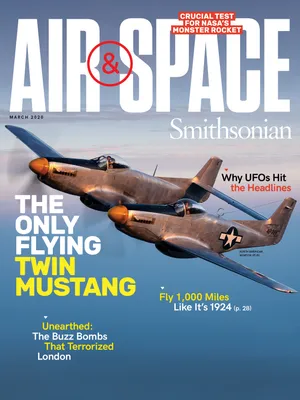A Tiny Moon Rover With a Big Impact
A new Japanese donation to the National Air and Space Museum points to the future of lunar exploration.
:focal(1309x1003:1310x1004)/https://tf-cmsv2-smithsonianmag-media.s3.amazonaws.com/filer/f1/f0/f1f0114a-9c0d-4781-82e7-bea705a04371/16c_fm2020_sorato_keyvisual_live_copy.jpg)
The call came out of the blue. About a year ago, the Smithsonian’s National Air and Space Museum curator Matt Shindell was contacted by a representative of ispace, the private Japanese aerospace company that was one of five finalists in the Google Lunar X Prize competition. Founder Takeshi Hakamada wanted to donate the company’s entry, the Sorato lunar rover. Was the Museum interested?
“It was really exciting,” says Shindell. “It wasn’t something that I had been expecting. Because we’re a national museum, most of our artifacts dealing with planetary exploration come from NASA. It’s great that around the world people think of the Air and Space Museum as a place that can inspire future technologies and activity in space. We’re the national museum, but in a way we’re also a museum for the entire world. ”
Hakamada had always been interested in space; he grew up watching Star Wars movies, and received his master’s degree in aerospace engineering from Georgia Tech. But it wasn’t until a SpaceShipOne pilot visited the university campus to give a lecture that everything clicked.
“I was so inspired by the lecture that it made me decide to enter the private space industry,” Hakamada said by email.
/https://tf-cmsv2-smithsonianmag-media.s3.amazonaws.com/filer/97/fe/97feb91e-6882-4c08-8dd8-bdd1c9e9699c/16a_fm2020_nasm2019-06898_live.jpg)
While the Google Lunar X Prize competition was canceled without a winner, ispace says it will launch a lander to the moon by 2021, and deploy lunar rovers on the moon’s surface by 2023.
At just a little over eight pounds, the four-wheel Sorato rover is the smallest space-qualified rover in the world. It was built over a decade, and most of the work was carried out by a small team of volunteers.
“That’s not the norm in space business,” says Shindell. “You might compare it to a Silicon Valley-startup story where you have a small team of very dedicated people who think that something could be profitable in the long run, but for now are mainly working on it because they think it’s a great idea, and they want to make it reality.”
Sorato will be displayed in the new Future of Spaceflight gallery, which is scheduled to open in 2024. The gallery is devoted to commercial spaceflight, says Shindell, and will cover “everything from space tourism to mining in space, to ventures like SpaceX where they’re trying to bring down the cost of spaceflight, and ultimately plan human missions to Mars, as well as robotic endeavors, like the ispace story.”
To create the gallery, the Museum is collecting artifacts from Virgin Galactic, SpaceX, ispace, and several other companies. But even within the commercial spaceflight field, ispace stands out. “The company plans to take rovers based on this same design to the moon,” says Shindell. “It’s wonderful that we were able to collect a piece of flight-ready hardware that was built for a specific purpose—the Google Lunar X Prize—but that is going to have a future life beyond that prize because the company has developed a good piece of technology that will build into what will hopefully be a sustainable business enterprise.”
And how does Hakamada feel about the rover donation, now that it’s official? “While the Google Lunar X Prize ended without a winner,” he says, “it sparked a new excitement in the space industry, and boosted interest in private lunar exploration. I know SpaceShipOne is on display at the National Air and Space Museum, and I’m very happy to [have a space vehicle ] inside the same Museum. In the same way that I was inspired by SpaceShipOne, I hope that Sorato will also be seen as a symbol of the dawn of private space exploration for future generations who visit the Museum.”
